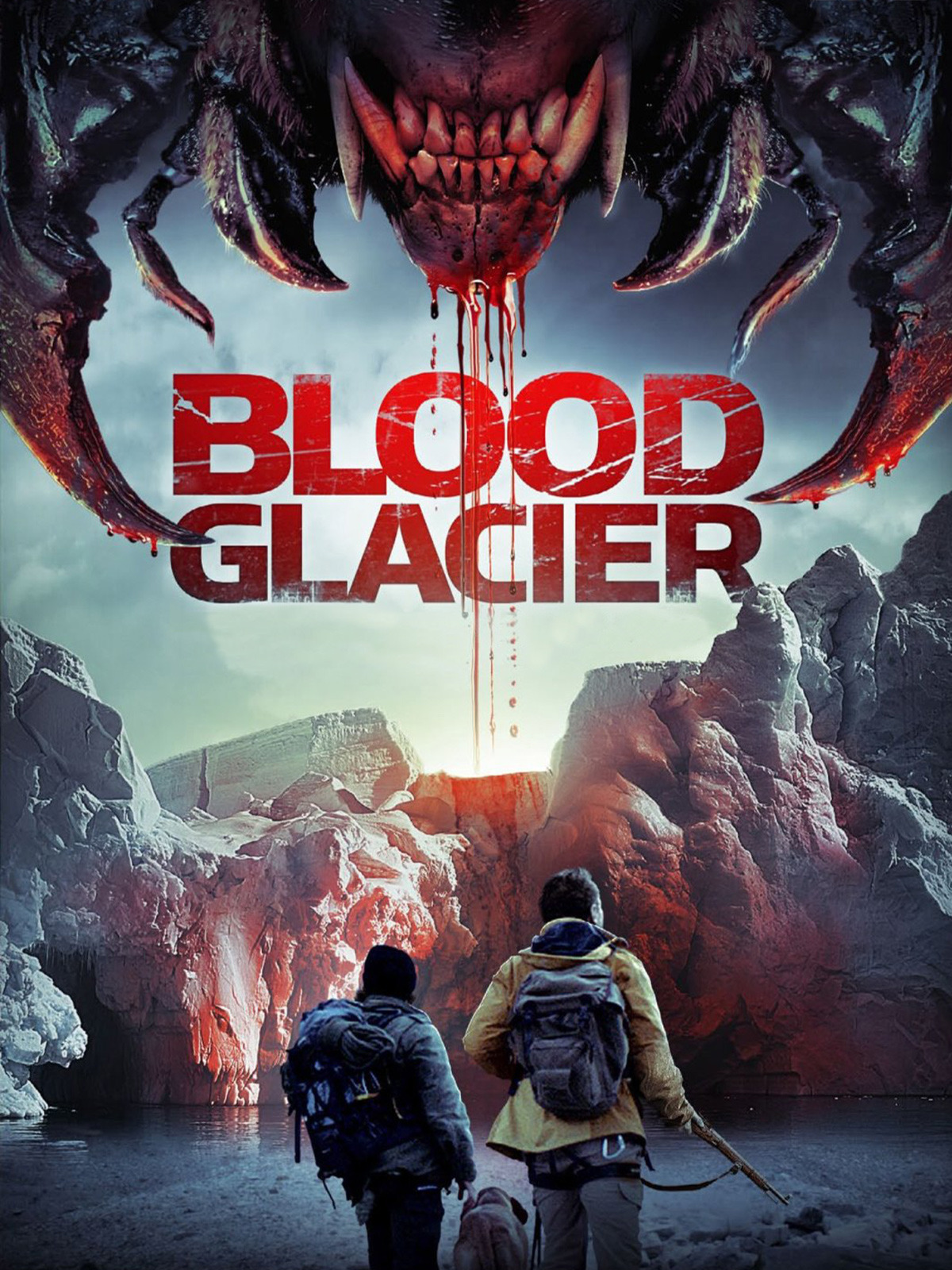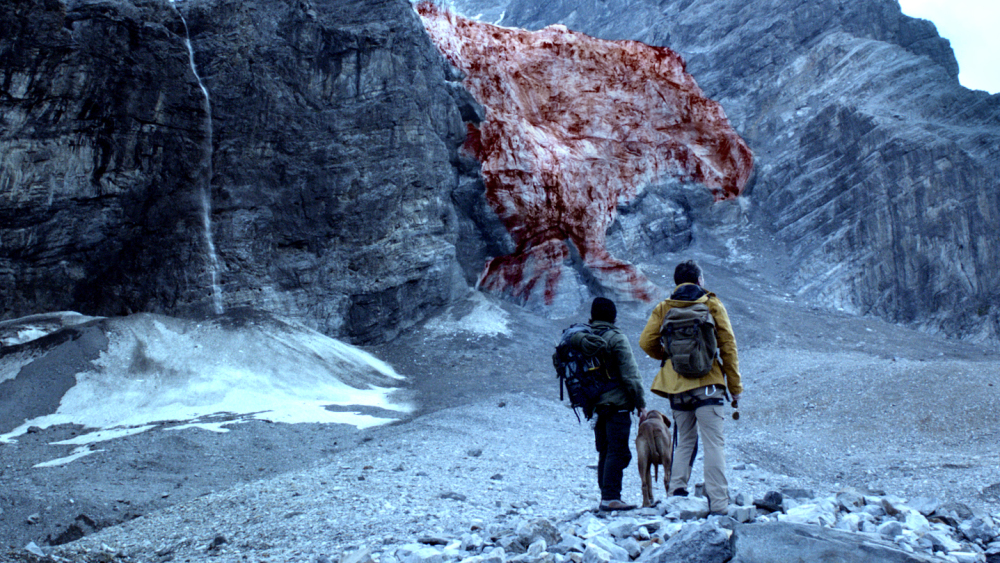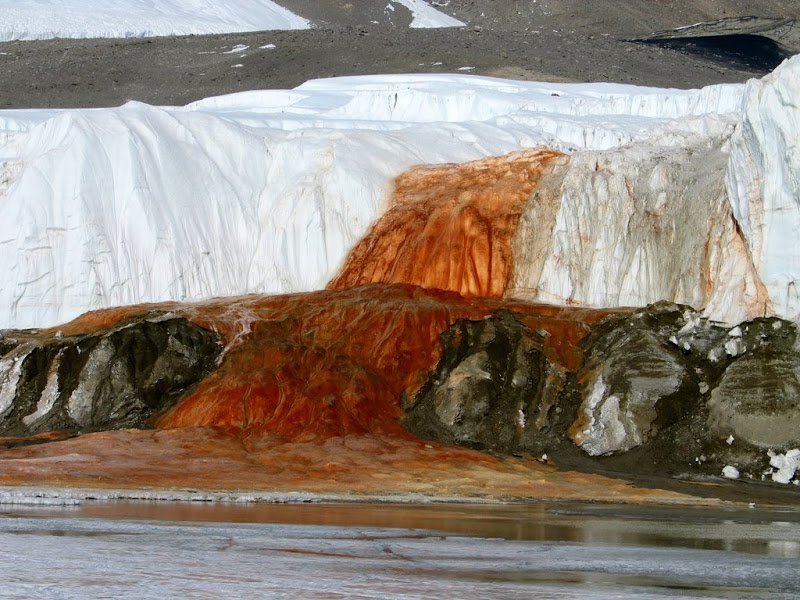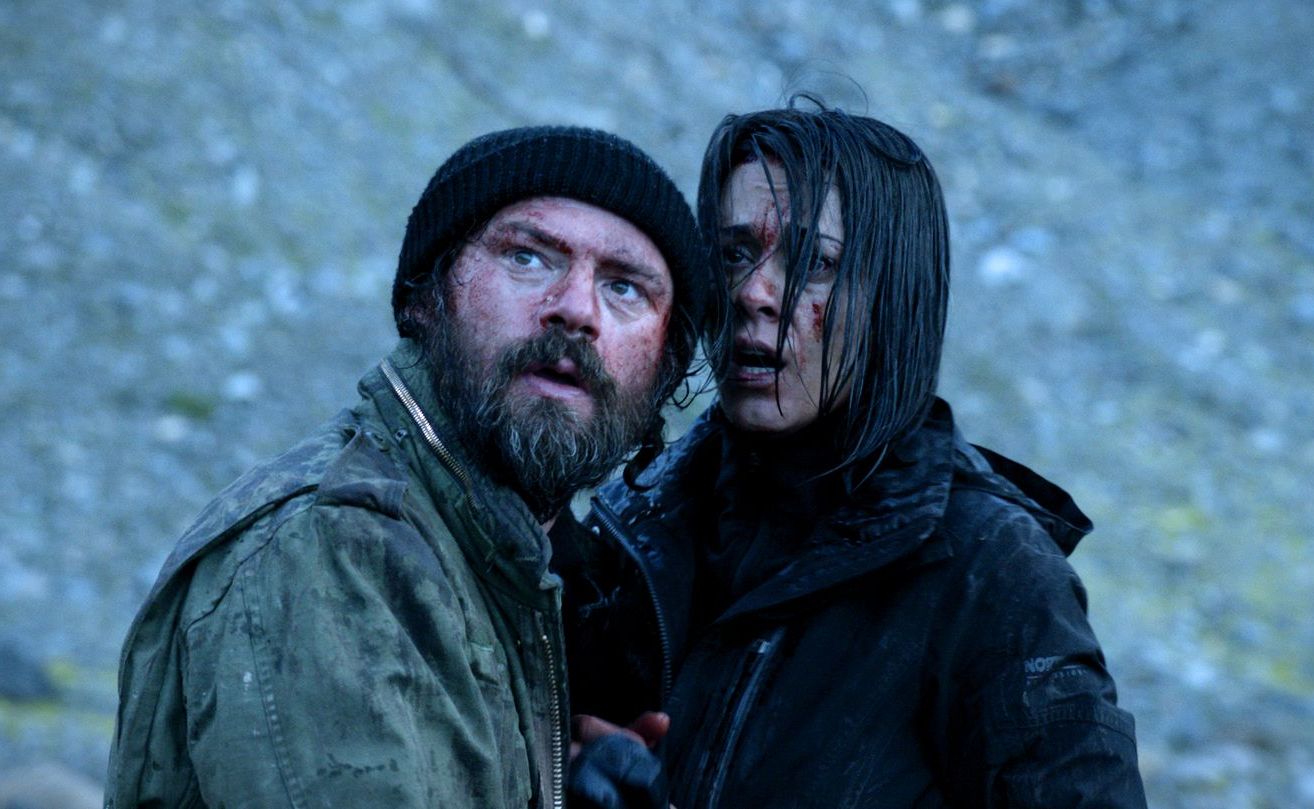An ancient frozen life-form waking up from climate change, a remote scientific research station, a team of four people and a dog. Is this anything you have heard before? No! You are mistaken! With only three clues, you will not be able to figure out the answer. If you were thinking of “The Thing,” you were mistaken.
This article is about the 2013 film “Blood Glacier,” also known in Austria as “Blutgletscher.” The global premiere of this Austrian film, directed by Marvin Kren and written by Benjamin Hessler, took place at the Toronto International Film Festival. In this film, Gerhard Liebmann, Edita Malovcic, and Brigitte Kren, the director’s mother, play important roles.
You have to admit that seeing the red marks on the pristine glacier for the first time gives you a shiver. But there is more to this film than meets the eye. There is body horror, monster horror, environmental horror, and a message for everyone. I have previously provided you with the plot’s hints.
The glacier’s red hue derives from bacteria that, when swallowed, fuses the host’s DNA with its food DNA, resulting in a mutant, hybrid monster that is extremely aggressive. The scientists are terrified, and the environment minister appears with a group of people who are being endangered by these horrific hybrids. Will they be able to escape the dangerous scenario or will they perish? Let us see what happens.
Exploring The Blood Glacier – Released in 2013

The film started with a warning on the effects of global warming, stating that the glaciers of Antarctica and the Alpine region are disappearing fast. Though the consequences are not clear, it is true that life on Earth would change forever. The plot is then shifted to the Climate Research Base in Austrian Alps, at an altitude of 3500m with three scientists, Harald, Falk, Birte, and one technician with a dog.
Janek, the technician at the research base, was highly experienced and capable but mostly stayed drunk and owned a dog named Tini. While walking on the glaciers one day, Janek and scientist Falk, to their horror, discovered a bloody-looking glacier. As Falk collected samples from the red glacier, Tini ran off to a cave as it heard some noise from there.
After some time, Janek heard Tini barking alarmingly, and he hurried to the cave where he found Tini injured in the stomach and the remains of a dead fox. Janek had been hurt and was bleeding, and while he was attending to the injuries of Tini, it started licking Janek’s blood.
As scientist Birte analyzed the sample, at first, she thought that the sample was botanical, but then she found out that the capsule cells were falling apart probably due to UV radiation or some contamination in the container.
So, Birte wanted to go back and retrieve some more samples from the blood glacier for further analysis. Janek refused to go back to the blood glacier as he was drunk, it was getting dark, and he believed there was a fox with Rabies, so it was unsafe.
Meanwhile, the environment minister and her group reached there for hiking and investigating about melting of glaciers. With that group arrived Tanja, Janek’s ex-girlfriend, while an excited Janek consumed a lot of morphine and just passed out. Late at night, he was suddenly awakened by some noise, and as he looked into the trash, he saw a deformed, mutated fox-beetle that charged at him.
Before Janek could bring out the gun, the animal escaped. As Janek went inside to get the gun, he stated that he would inform the minister’s group about the danger and request them to cancel the trip. Others tried to convince him that the effect of alcohol and morphine had probably taken a toll on him. Accordingly, Janek tried to warn Tanja about the rabid fox and asked them to turn back, but Tanja didn’t pay any attention to him.
As Janek and Birte went to the blood glacier again, they were startled to find that the glacier was white again. As Birte grilled inside the glacier to collect the sample, Janek was attacked by a strange crustacean creature. They took the animal into the station and examined it.
Eventually, the photographer in the minister’s group suddenly got stung by an insect too. He killed it with a slap but found it to be quite big. Back at the center, Birte explained that the microorganism rapidly mutated inside the host body and produced aggressive hybrids, but we will discuss it later. Janek hurried back to his cabin and saw that Tini’s injury was turning fatal.
He took a gun and aimed it at Tini. The look on Tini’s face when it saw Janek pointing a gun at him is beyond any words. Janek couldn’t just pull the trigger, and meanwhile, Tanja requested him to wait for some more time before he put Tini to sleep. But finally, Janek convinced Tanja to take the shorter route to the Research Center. The scientists asked Janek to keep everything a secret as publicity would ruin their chance of one of the century’s most significant discoveries.
Meanwhile, a girl named Geli appeared out of nowhere, running from a monstrous falcon-wasp which attacked her viciously, while the photographer, stung by a bug, became restless as he climbed up the mountain.
As the injured girl joined the group, the hybrid bird returned and killed Lucca, the minister’s bodyguard. The group ran frantically and reached the Research Center. Janek desperately looked for the satellite phone, but Harald told him that Falk and Birte had taken it with them at the Isolation Chamber. Soon Janek and Tanja realized that Tini was in incredible pain, and Janek had to take the most challenging decision of his life and put Tini to sleep.
That scene was so heart-wrenching, especially for pet lovers. To make things worse for Janek, Tanja informed him that she had aborted their child. It is hard to believe that she would throw such devastating news at a man who is just about to lose his beloved pet.
Meanwhile, Birte and Falk took the crustacean monster to the isolation chamber but as soon as Birte opened the box, the creature grabbed her face. In an attempt to rescue her, Falk hit the monster with a stone, while in the process, he accidentally smashed Birte’s face. Back at the center, Harald confessed everything that had happened, and suddenly Falk was back as he was petrified. Soon a moth-ibex hybrid started attacking them.
As it broke through the window, the minister used the drilling machine to slaughter the creature. Janek, Tanja, and Falk went to retrieve the satellite phone, and the remaining group attended to the injured Geli. They performed an operation and pulled out the hybrid creature that was growing inside her wound in the leg and burnt it.
As the minister and her group relaxed, they heard someone banging on the door. Soon as they opened the door, the injured photographer burst in. He was in a terrible state, and soon hybrid bugs started popping out of his injury.
Amidst the commotion, Harald accidentally set fire to himself and died. Janek and Tanja found Birte’s mutilated body inside the cave in the mountains while Falk took them there at gunpoint to hide his crime. But the fox-beetle hybrid pounced and killed Falk before attacking Janek. Tanja managed to ambush it with an ax. They informed the rescue center with the satellite phone and detected smoke from the Research Center.
As they rushed back, they found the minister, her husband, and journalist Irene had survived as they heard the helicopter approaching. Before leaving, Tanja found out that a human hybrid was born from Tini’s wound as it had licked Janek’s blood. They took the child, and as the helicopter flew, they could see another blood glacier at a distance. The hybrid wasp-bird charged towards the camera as the film concluded.
The film is exceptionally well executed with some exceptional acting from the cast, especially Gerhard Liebmann, who received the best actor prize in the Austrian Film Award in 2014. The monsters were primarily designed with practical effects, but without any comparison with Rob Bottin or StudioADI, they were satisfactory within the budget of the film.
It is true that the plot appears highly inspired by ”The Thing,” but the trend of following a superhit plot has been going on in the film industry for a long time. However, the blood glacier and the mutating bacteria take the story to the next level. Let me tell you; there is a Blood Falls glacier in Antarctica, but don’t worry! There is no blood there, but iron-rich hypersaline water that comes out of the fissures in Taylor Glacier of McMurdo Dry Valleys in East Antarctica.
Also, glaciers in French Alps also have blood-like stains, but they are actually microalgae blooms. In fact, French scientists have started a project called AlpAlga for further research on this matter. It is also worth mentioning that beneath the Taylor Glacier, there is a small body of water like a time capsule containing an age-old group of microbes. Somehow, I feel that the plot is also inspired by this fact.
Exploring The Deadly Mutating Bacteria of Blood Glacier

Let us now discuss the blood glacier microorganism. The red color of the bacteria imparts the bloody color to the glacier. Birte was the first to discover that the blood glacier bacteria were genetic laboratories and incubators at the same time. They penetrate the bodies through food, use the host’s DNA and any other DNA present in the host’s stomach, and produce random hybrid species utilizing a trial and error method or any different evolutionary principle.
As Birte explained, the fox probably drank the glacier’s molten snow water and then had consumed a beetle and some other animals. So, the bacteria will combine all the available DNA in the fox’s stomach and develop a mutated hybrid which will eventually burst out of the host’s stomach. This somehow reminds me of the parasitoid Alien macro virus of the ”Dreamcatcher” which also used to snap out of the host’s body though it didn’t mutate.
This is how probably we get the first glimpse of the fox-beetle hybrid. The hybrid burst out and injured Tini, thus infecting him with the microbe. When Tini had licked the blood of Janek, the human DNA and dog DNA had combined to produce a hybrid which Tanja took with her in the last scene. I don’t think this mutation is possible in a human stomach as humans usually cook their food, and essentially there is nothing left of any DNA of the food for the microbe to mutate with.
But in the case of Geli and photographer, Urs they were only infected with the bacteria. Without any severe mutation in their case, only strange creatures developed at the site of injury, similar to the hatching of eggs.
As animals don’t cook their food, there is plenty of possible genetic coding left in the stomach, which the bacterial cell can use and combine. Bacterial cells are one of the oldest forms of life present on Earth. Over millions of years, they have developed different biological pathways to edit genes. As the glacier melted, the bacteria passed on to the immediate pool of water, while the insects were the first to come in contact with it.
As their predators consume these insects, the bacteria combine the insect’s DNA with the host’s stomach cells, and a new species of hybrid start to gestate. Thus, most of the mutations involve an insect, like falcon-wasp or moth-ibex hybrids. However, these bacteria seem to have a weakness towards UV radiation because the second time when Birte and Janek went to retrieve samples, there was no trace of the bacteria.
If these bacteria are vulnerable to UV radiation, how did they survive the mass extinction due to UV radiation millions of years ago? Well, there is a theory that states that deep oceans have protected many life forms, including them, from mass extinction. Again, during the ice age, many life forms have remained frozen in ice, in a time capsule only to evolve in due course of time, just as mentioned in the Taylor Glacier. But so far, no mutations have been noticed in the area. Still, it is better to keep a watch on what’s happening around us.
Similarities and Dissimilarities between Blood Glacier Bacteria and The Thing

By this time, you must be thinking about the numerous similarities between the Blood Glacier Bacteria and the organism of ”The Thing”. Well, you are not alone. Even the critics compared the two films minutely. Do you remember that the organism on ”The Thing” was also found in the remote area of Antarctica below the ice?
The organism of ”The Thing” had the capability of assimilating at the genetic levels of its hosts, while the blood glacier bacteria also combined all the available genes of its hosts. The resultant creatures in both cases were fierce and aggressive and attacked any living organism crossing their paths. Both the organisms were ancient species frozen beneath the ice, waiting for a favorable time to begin the life span.
Though the monster from ”The Thing” is considered extraterrestrial, nothing was spoken about the origin of the blood glacier bacteria. One of the significant threats of the extraterrestrial organism was that it was not vulnerable to the conventional forms of attack. It could only be killed by fire or molecular acid. But the hybrids formed by the blood glacier bacteria could be killed in any way in which a normal organism could be killed.
We saw Tanja killing the fox-beetle hybrid with an ax while the ibex-moth hybrid was killed by the minister with a drilling machine. But the organism of ”The Thing” was definitely more powerful and dangerous as it has assimilated numerous genes of human beings accumulating their memories and intelligence, which is lacking in the blood glacier hybrids.
Also, the threat of the blood glacier bacteria was enormous and beyond the control of human beings as the bacteria only succumbed to UV radiation, and considering the vastness of the ice glaciers in Antarctica, no one knows where and when the microbes would appear. We can certainly come to some conclusions about the bacteria or have some idea about the hybrid animals that they created, but there could be practically no conclusion about the alien monster, and that is why it is called ”The Thing”.
Why You Should Watch Blood Glacier

Blood Glacier is not free of flaws. One major flaw is the appearance of Geli out of nowhere while no one even asked her what she was doing in such a remote area. Probably the creature she was running from was of greater importance than checking her background. But the film will gain your attention. Though there are no famous actors, or there are no incredible special effects, and it is just another horror B movie, the film strikes the right chord somewhere.
The emotional moments between Janek and his dog are priceless. You might be intrigued about the blood glaciers of blood falls in real life. If you can find out more about these blood glaciers, do let us know in the comment section. We are keen to know too!
